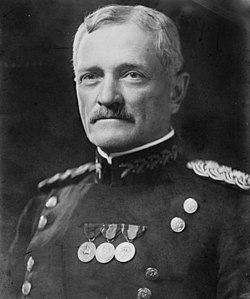John J. Pershing | |
|---|---|
 | |
| Birth name | John Joseph Pershing |
| Nickname(s) | "Black Jack" |
| Born | September 13, 1860 Laclede, Missouri, U.S. |
| Died | July 15, 1948 (aged 87) Walter Reed General Hospital Washington, D.C., U.S. |
| Buried | Arlington National Cemetery, Arlington County, Virginia, U.S. |
| Allegiance | United States |
| Branch | United States Army |
| Years of service | 1886–1924 |
| Rank | General of the Armies |
| Service number | O-1 |
| Commands | 8th Brigade [1] [2] Mexican Expedition American Expeditionary Force First United States Army Chief of Staff of the United States Army |
| Battles / wars | Indian Wars |
| Awards | Distinguished Service Cross Distinguished Service Medal Silver Star Honorary Knight Grand Cross of the Order of the Bath (United Kingdom) Légion d'honneur (France) |
| Signature |  |
General of the Armies John Joseph "Black Jack" Pershing (September 13, 1860 – July 15, 1948) was a senior United States Army officer. His most famous post was when he served as the commander of the American Expeditionary Force (AEF) on the Western Front in World War I, 1917–18.
Contents
- Organizations
- Military ordnance and other equipment
- Buildings
- Schools
- College buildings
- Military buildings
- Other buildings
- Places
- Streets
- Squares and plazas
- Parks
- Other places
- Miscellaneous
- References
Pershing was immensely popular after World War I, and as a result a large number of organizations, equipment, streets and buildings are named after him throughout the United States and abroad: